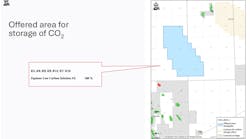OYO Geospace gets seabed acquisition system order
OYO Geospace has entered into a $7 million sales contract with the Bureau of Geophysical Prospecting (BGP) for a retrievable seabed data acquisition system. The 4,000-channel, four-component data acquisition system marks the first purchase by BGP for an OYO Geospace product.
The company will deliver the system in 3Q 2006, at which point they will recognize $6.3 million of the contract revenues. After a specified time period of successful operation, OYO Geospace expects to receive and recognize the remaining $0.7 million of contract revenue. This sales contract is the third reservoir characterization system scheduled for delivery by the company in fiscal year 2006. OYO Geospace shipped the first of its new slimhole seismic data acquisition systems for borehole applications in October 2005. In December 2005, the company received an award for a $7.6-million contract to deliver a permanent seabed system to BP in the North Sea. The purchase will help BGP achieve its goals of an expanded seismic fleet.
“BGP is building a seismic fleet consisting of two deepsea ocean bottom cable (OBC) seismic vessels in China,” said Wang Tiejun, president of BGP. “This OBC fleet will be equipped with OYO Geospace’s four-component armored-cable seabed seismic data acquisition system. With these systems, BGP will be able to provide advanced high-definition reservoir seismic services to oil companies worldwide.”
New seismic ventures for Veritas DGC
Veritas DGC Inc. has announced two new seismic ventures. The first is a charter agreement for a new-build seismic research vessel with Eidesvik Offshore ASA. Veritas’ Viking Maritime Inc. will charter the vessel from Eidesvik for a fixed period of eight years, with the option to continue for up to an additional 10 years.
The vessel will be the fourth to be owned and operated for Veritas by Eidesvik on worldwide seismic operations. The vessel will be 105 m long with an extended breadth of 24 m, and will have the capability of towing up to 12 long streamers. The gross tonnage is approximately 11,500 metric tons, and the vessel will have a crew accommodation for up to 70. The construction cost of the vessel, excluding seismic equipment, is NOK 366 million (approximately $55 million).
As with the three other vessels that are under charter agreement between the two companies, Eidesvik will provide the maritime crews and all marine operations and management, while Veritas will provide all seismic-related aspects of operations. Delivery is scheduled for February 2007.
Veritas also announced that one of its subsidiaries has entered into an agreement with BP America Production Co. to perform wide-azimuth seismic surveys in the deepwater GoM. The six-month program is expected to begin in the summer of 2006 with a minimum price tag of $50 million.
“The program consists of a series of towed-streamer 3D wide-azimuth surveys as well as a high-resolution 4D survey,” said Timothy L. Wells, president and COO of Veritas.
Wide-azimuth towed-streamer seismic acquisition uses multiple seismic sources from multiple vessels to provide acoustic illumination of the earth’s interior from multiple directions relative to the seismic receivers in the towed-streamers.
“This enhanced illumination allows for a deeper and richer view of subsurface geology through the use of state-of-the-art computer imaging techniques,” Wells said.
EMGS deploys Ibrix software
Ibrix Inc. says that Electromagnetic Geoservices AS (emgs), a seabed logging company, has implemented the Ibrix Fusion Parallel File System, an enterprise-class fully-integrated single namespace software suite, for generating more sophisticated oil and gas analyses and surveys and accelerating its delivery to oil and gas customers worldwide.
EMGS provides information that helps exploration professionals locate commercial hydrocarbon reservoirs and rank prospects for drilling, reducing the risks and costs of drilling dry holes.
As the company has expanded its offerings to include intensive modeling, data acquisition, processing, and interpretation services, demand for its services has increased, resulting in the need for increased computational power.
The Ibrix solution is integrated with 500 Dell PowerEdge 1855 blade servers and 12 terabytes of EMC CX700 storage, enabling emgs to scale its business and gain a competitive advantage by reducing the time needed to deliver sophisticated information products to customers.
“The combination of the Ibrix/Dell blade engine allows emgs to generate processor- and FLOPs-intensive answer products in a much shorter time,” says Helge Stranden, IT manager at emgs.
“Since implementing the Ibrix solution, we are processing over ten times more surveys than before and can feed multiple jobs through in quick succession.
“Now we can acquire more data and process multiple jobs in a shorter timeframe without experiencing bottlenecks along the way.”
“Oil exploration is an expensive and highly competitive business, with no room for error,” says Shaji John, Ibrix CEO.
“Today’s announcement underscores the importance of having scalable file serving that can deliver the high performance, availability, and scalability needed to allow analysts to pinpoint with complete precision where and when to drill.”
OHM survey is first of its kind for the Falklands
Offshore Hydrocarbon Mapping plc (OHM) is conducting a shallow water Controlled Source Electromagnetic Imaging (CSEM) survey for Rockhopper Exploration plc in the North Falkland Basin, the first survey of its kind in the region.
The data acquisition program is being conducted off the survey vesselMV Aureliaover a number of prospects in water depths ranging from 150 to 500 m, using one of OHMs specialized survey crews and incorporating OHMs proprietary EM source and receiver systems.
Prior to implementing the CSEM survey, an electromagnetic response was calculated for the prospect, which was used to assess the influence of local structure, such as salt or volcanic bodies, on the outcome of a survey. Target parameters such as reservoir thickness, resistivity and lateral extent are examined, and the resolution to which these parameters can be determined is then quantified. In the event that there are competing geological interpretations of existing data, modeling will be implemented to determine how well these can be distinguished using CSEM.
In order to arrive at the best resolution of target structures and properties, the model results are used to determine the ideal source tow and receiver array geometries and source transmission frequencies. Once the modeling process has been completed, OHM can then confirm whether CSEM will provide conclusive indication of the presence of resistive layers that are consistent with hydrocarbon reservoirs in the modeled prospects.
OHM also possesses a range of 1D, 2D, and 3D inversion algorithms that can be applied to the data, as well as their diffusive E-field focusing (DEFF) imaging technique, which allows resistivity volumes of the earth to be created.
OHM Chief Scientific Officer Dr. Lucy MacGregor finds the North Falkland Basin well-suited for the CSEM technology. She commented: “The North Falkland Basin is a new area for the application of the CSEM technique and as the targets aret in relatively shallow water depths, the survey provides us with the opportunity to further demonstrate our recently-launched shallow water technique.”•


